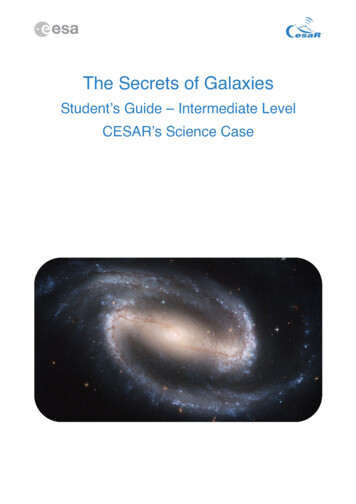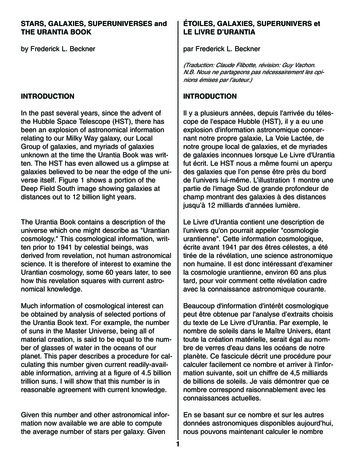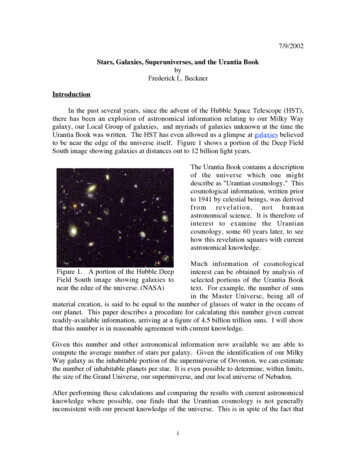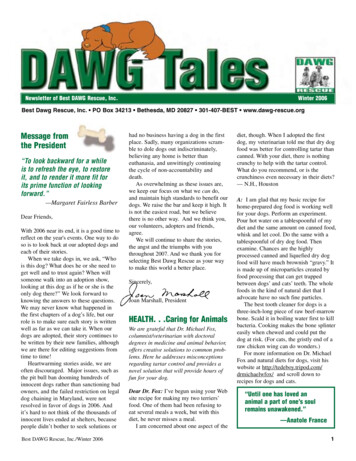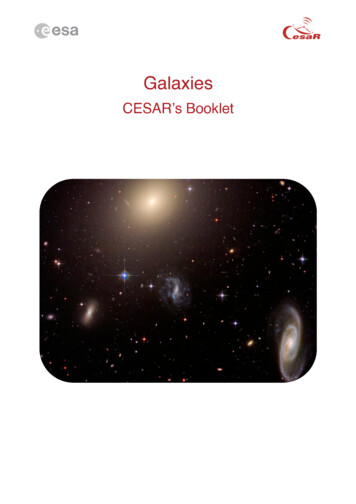
Transcription
GalaxiesCESAR’s Booklet
What is a galaxy?Figure 1: A typical galaxy: our Milky Way (artist’s impression). (Credit: NASA)A galaxy is a huge collection of stars and interstellar matter isolated in space and bound togetherby gravity. There are thought to be over 100 billion galaxies in the Universe, mainly residing inclusters and groups. The most well known galaxy is our own Milky Way –and indeed, the termgalaxy comes from the Greek word ‘gala’, which means ‘milk’.Most galaxies have a total mass between 10,000 and 10 trillion solar masses, and sizes between afew to over several hundred kiloparsecs (1 kpc 3.086 1016 km). The Milky Way (shown in Figure1) contains over 100 billion stars, including the Sun, and the stellar disk extends to about 30 kpc indiameter; it also has a stellar halo with a diameter of about 100 kpc, and a dark matter halo thatmay extend well beyond this.Galaxies2CESAR’s Booklet
Types of galaxiesThe Hubble Tuning ForkGalaxies are classified according to their shapes in optical (visible-light) images. The mostcommon classification scheme in use today is the Hubble classification scheme, or Hubble tuningfork (Figure 2). In this scheme, galaxies are classified into the following broad categories:ellipticals, spirals, and irregulars. The ellipticals are smooth and round or elliptical, the spirals areflat with a spiral pattern in their disk, and the irregulars have stars and gas in random patches.Spirals are further classified into two types: regular spirals, where the arms come right out of thegalaxy centre, or barred spirals, with the arms starting from the ends of a bar of gas and starsgoing through the centre. The ellipticals are sub-divided by how round they are and the spirals aresub-divided by how loose their arms are and how big their bulge is.Figure 2: The Hubble Tuning Fork. (Credit: NASA/ESA)In 1936, Hubble put these groups onto a two-pronged sequence that looks like a tuning fork,because he thought that the galaxies started out as ellipticals, then changed either to regularspirals or barred spirals, and then to irregulars. However, astronomers now know that this diagramdoes not represent the evolution of galaxies.Galaxies3CESAR’s Booklet
Parts of a spiral galaxyContrary to ellipticals and irregulars that show no clear structure, spiral and barred spiralgalaxies have three clearly differentiated parts: The central part is called the bulge and contains de galaxy’s nucleus, which is in most (ifnot all) cases a supermassive black hole that the rest of components of the galaxy orbitaround. The bulge is spherical in normal spirals, while in barred spirals it appearselongated, with a bar connecting to the spiral arms. The bulge is surrounded by a flattened structure called the disk, which contains the spiralarms. Although stars in the arms are brighter, allowing us to recognise the spiral pattern,the regions between the arms are also filled with stars. The halo surrounds the bulge and the disk. It has a spherical shape and is subdivided intoa smaller stellar halo containing lots of globular clusters (very big and dense groups ofsibling stars with a spherical shape) and a larger dark matter halo wrapping the wholegalaxy. As a matter of fact, it is thought that every galaxy, of every type, is surrounded bya dark matter halo, but the nature of this dark matter –called like this because it does notemit light, in any frequency– is so far unknown.Figure 3: Parts of a spiral galaxy. (Credit: Pearson Education)Galaxies4CESAR’s Booklet
The sizes of galaxiesMost galaxies are small and faint and are called dwarf galaxies; they tend to be elliptical orirregular in shape. Only the most luminous and biggest galaxies are seen at great distances; thesespectacular giant galaxies are always ellipticals. Spirals have intermediate sizes: they are biggerthan dwarf ellipticals and irregulars, but smaller than giant ellipticals.Figures 4 and 5 give an idea of the variety of sizes of galaxies as compared with our own galaxy,the Milky Way.Figure 4: Comparison of sizes of dwarf galaxies with the Milky Way. (Credit: rhysy.net)Galaxies5CESAR’s Booklet
Figure 5: Comparison of sizes of a selection of galaxies with the Milky Way (encircled).(Credit: rhysy.net)The largest galaxy known is called IC 1101. This is an elliptical galaxy whose diameter isestimated to be approximately 1.7 Mpc. Compare this value with the 30 kpc diameter of the MilkyWay! IC 1101 is found at the centre of a rich galaxy cluster, and probably grew in size by eatingsmaller galaxies.The colours of galaxiesThe optical colours of galaxies vary depending on their types: Elliptical galaxies usually showyellowish or reddish colours, in contrast with spirals and irregulars that tend to look more bluish.Inside a spiral galaxy, the central part or bulge looks yellowish or reddish, while the disk containingthe spiral arms usually glow bluish; spirals are also surrounded by a halo of yellowish or reddishstars, often packed in spherical globular clusters (see Figure 3). Astronomers relate these colourGalaxies6CESAR’s Booklet
differences to the different types of stars galaxies contain: Remember that stars get reddish whenthey evolve off the main sequence, while young massive stars are blue. Thus, if a galaxy looksbluish, it means that it contains lots of young stars, while a yellowish or reddish galaxy will containmostly old stars. (Note that big, massive stars are the only ones bright enough to be observed atthe distances of most galaxies.)Since stars form from clouds of dust and gas, if a galaxy is rich in young stars, we expect it tocontain large amounts of interstellar gas and dust as well; while a galaxy that does not containmuch gas and dust will not have many young stars, as there is no material from which these starscan form. Therefore, we do not expect elliptical galaxies to be rich in gas and dust, and hence, theywill not look very bright in infrared and radio images (as they mainly show the emission of dust andgas, respectively). On the other hand, galaxies rich in young stars, like spirals, must be veryprominent in the infrared and radio.Stellar populationsIn the 1940s, German astronomer Walter Baade was able to resolve and study the stars inseveral nearby spiral galaxies. He noticed that they could be assigned to two main groups: Population I: Stars in this group are relatively young and have chemical compositionsimilar to our Sun. They are said to be metal-rich because of their relatively high contentof elements other than hydrogen and helium (called metals in Astronomy). These starsare located in the disks of spiral galaxies, moving in nearly coplanar, nearly circular orbitsaround the galactic centre. Population II: Stars in this group are older than Population II. They are metal-poor,meaning that their chemical composition is almost only hydrogen and helium, with verylittle traces of other elements. These stars are common in the bulges and halos of spiralgalaxies, and move in randomly orientated, highly eccentrical orbits around the galacticcentre.Galaxy formation and evolutionGalaxy formationAstronomers are just beginning to understand how galaxies form and evolve. They now think thatall galaxies began forming about 13 billion years ago, when the Universe was very young. In thebeginning, there were only very small clumps of stars and gas about the size of a million solarmasses (the size of a globular cluster) that started collapsing, forming larger structures. Thengalaxies would be drawn into clusters and superclusters by their mutual gravitational attraction.This theory is supported by the fact that there are many more dwarf galaxies than giant galaxies;they may have originated from cloud fragments that did not get incorporated into larger galaxies. Inaddition, at very large distances, most galaxies are small and irregular; since the further weGalaxies7CESAR’s Booklet
observe, the earlier in time (because light takes time to travel from the source galaxy to us), thismeans that early in the history of the universe, only small, irregular galaxies existed, as the onesshown in Figure 6.Figure 6: Small, irregular galaxies like the ones in these images from the Hubble Space Telescope areobserved at large distances. They are thought to be the ‘building blocks’ of current giant galaxies.(Credit: NASA/ESA)Another fact supporting this theory of galaxy formation and evolution is that collisions and mergersof galaxies are still observed today.Interacting galaxiesThe distances between galaxies are large, but not extremely large compared to their sizes: only afew times bigger. Thus galaxy collisions do happen quite often. The shapes of galaxies may getremarkably distorted in the collision, as in the example shown in Figure 7. The two galaxies caneven merge to form a larger galaxy. The giant elliptical galaxies usually found close to the centresof galaxy clusters most likely formed from the collision and merging of smaller galaxies.Stars inside a galaxy do not collide because the distances between them are hundreds ofthousands to millions of times larger than the sizes of stars; for the same reason, when twogalaxies collide, the stars will pass right on by each other without colliding, although their orbits canbe radically changed.On the contrary, the gas clouds in galaxies are much larger than stars, so they will likely hit theclouds in another galaxy when the galaxies collide. As a consequence, the clouds compress andcollapse to form a lot of stars in a short time. Galaxies undergoing such a process are calledstarburst galaxies.Galaxies8CESAR’s Booklet
Figure 7: The Mice, two colliding galaxies, as observed by the Hubble Space Telescope.(Credit: NASA/ESA)References Astronomy Notes by N. Strobel: http://www.astronomynotes.com Cosmos, the SAO Encyclopedia for Astronomy: http://astronomy.swin.edu.au/cosmos/Authors of this Booklet Belén López Martí Beatriz GonzálezGalaxies9CESAR’s Booklet
Galaxies 6 CESAR’s Booklet Figure 5: Comparison of sizes of a selection of galaxies with the Milky Way (encircled). (Credit: rhysy.net) The largest galaxy known is called IC 1101. This is an elliptical galaxy whose diameter is estimated to be approximately 1.7 Mpc. Compare this value wi
